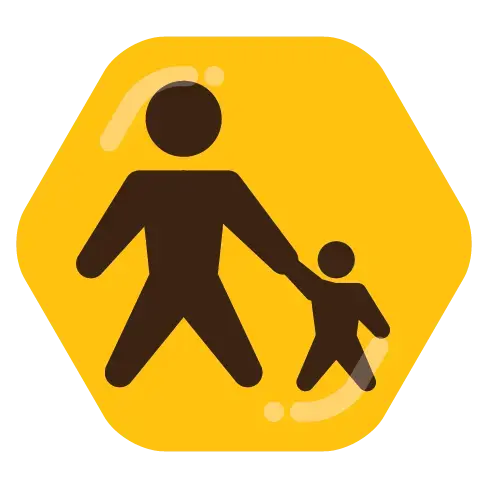FZDC
- 2 Posts
- 4 Comments
- FZDC to

- •
- 2Y
- •
My kids are still young, so some of my list might not work for OP’s 8 year old, but if it’s an all ages discussion, I’ve got a few, some of which might translate to more ages.
Free stuff when weather is nice (relatively speaking, in this unusually hot summer):
- Playgrounds/parks, including splash parks and swimming pools.
- Scavenger hunts on a walking loop: give a list of things to find, either by just seeing and checking off, or things that can be collected (e.g., acorns falling from trees). Combine with farmer’s market or other street markets to make the journey slightly more productive.
Free stuff when weather isn’t as nice:
- Free Museums, if you have any nearby.
- Cooking at home together. (This is free in the sense that it doesn’t cost any more than feeding yourself by cooking without the kids.) Things involving dough or batters are often fun for kids: pizzas, muffins, pancakes, etc. My daughter loves “whipping” cream by putting heavy cream in a mason jar and just shaking it for a few minutes, until her arms are too tired. I also like dishes where they understand every step, even if they can’t perform every step involving high heat or sharp objects: fried foods that get battered/breaded before frying, ravioli or dumplings that need to be filled/assembled before boiling, etc. Some steps are more about them watching than them doing anything, but if they take an interest at a young age you might be able to introduce teaching them how at the appropriate age. My kids obviously aren’t allowed to touch the controls on the stove/oven, much less the open flame of the outdoor pizza oven, smoker, or charcoal grill, but always like watching me light up some fires. Little pyros.
- Photography. An old unused cell phone might be good enough, but kids can learn the basics of capturing a moment or composition/framing just from the lives around them. My kids have standing permission to take my (locked) phone to take pictures, and I’m probably going to buy a dedicated kid-friendly/rugged point and shoot for them soon.
Low cost activities:
- Art projects at home: markers and crayons, sure, but one-off projects that involve sculpting or assembling or gluing something 3D can sometimes mix it up.
- Some sort of fun musical instrument where the kids can be creative with audio: toy keyboards/xylophones, kid-oriented electronic beat machines or drum kits, etc.
- Museums or other fun places with one-time memberships where you pay once per season/year to go for free each time. Some parks/pools/playgrounds might be privately run, but could sometimes be worth the cost of a season pass.
- Car camping overnight in state/national park areas. Work in a few day hikes and other outdoor activities, make a thing out of setting up the shelter/tents, maybe starting a fire (weather and location dependent), making smores or other camping friendly food, etc.
Higher cost activities:
- Hotel or house rental near a beach or lake, with beach activities during the day.
- Sending them off to visit out-of-town grandparents and other family (or hosting family to come visit). A big part of the fun of summer camps is the people anyway, so giving the opportunity to interact with loved ones they don’t normally get to see is often a fun break from the routine. Depends on the people in your family, though.
- Big theme parks or water parks with higher cost of admission (and often more involved travel logistics).
I’m probably missing a bunch. But that’s what I can think of right now.
OP, how about you? You mentioned you’ve already got some things going on, maybe we can compare notes.

You’re right that a big part of it is social/cultural expectations of the people around those parents. If Bluey is normalizing what it means to be an involved dad for millennial dads of kids born between 2015 and 2025, we’ll start to see critical mass of that kind of expectation.
In my social circle (millennial professionals living in big cities in the East Coast), it seems the knowing how to cook well and owning a dog are really important for the dating scene, and seem to set a certain baseline expectation for what unpaid household work one is able to do alone or with a significant other. And, if we’re getting married later than previous generations (marrying between 30-35 to people we knew for 2+ years), and engaged in active family planning (that is, birth control), there’s an opportunity to show during the dating years how career and household responsibilities interplay, before the couples actually choose to have children together.
And it feeds back onto itself. I personally don’t really run into the issue of diaper changing stations in women restrooms but not men’s restrooms (where I live in DC, most restrooms are single stall unisex, with one or two diaper changing stations that are also in unisex stalls). There’s a pretty healthy representation of other solo dads at the playground, or at daycare pickup/dropoff, etc. It’s not 50/50, but it’s closer than in some other cities I’ve lived in, or the stories I hear from family and friends elsewhere.
So we’re moving there. Our generation just has to continue to model the behavior for those that come after (especially our own children).

I can’t seem to shake the feeling that child care is in an economic death spiral right now.
If a child care facility follows NAEYC standards by having 2 teachers for 8 infants, there’s no way around the fact that the revenue per child needs to cover 1/4 of the cost of a teacher’s salary after all other expenses (rent, insurance, utilities, administrative overhead, supplies). If the costs attributable to that class is at $4000/month, and the teacher salaries (including taxes, insurance, retirement, PTO, paid holidays, etc.) are $4000/month, that’s a total of $12k/month to split between 8 infants: $1500/month at minimum, or $2000/month for a minimal buffer/reserve against emergencies, vacancies, etc.
Meanwhile, the actual workers can’t even afford to pay for that child care on their own salaries taking home $3000/month (cost to employer $4000/month), so they end up exiting the career when they have kids of their own, or their child care facility gives up a revenue spot as a perk for retaining workers (requiring a higher charge for all the other kids attending).
If the economics are unsustainable for the parents and for the workers, how can this industry avoid turning into a luxury service only for the rich?